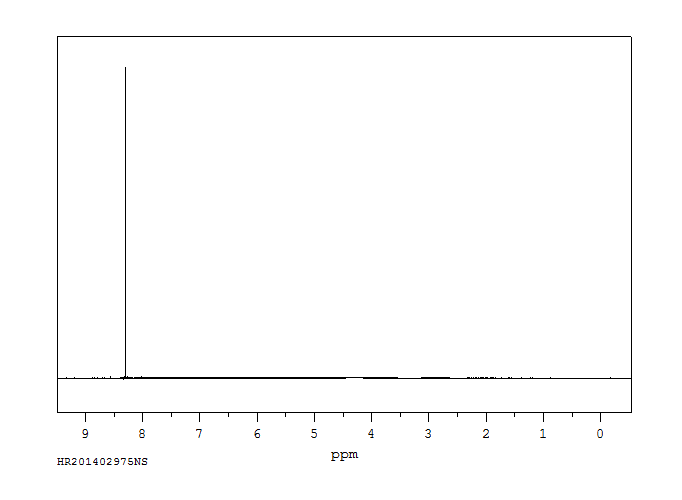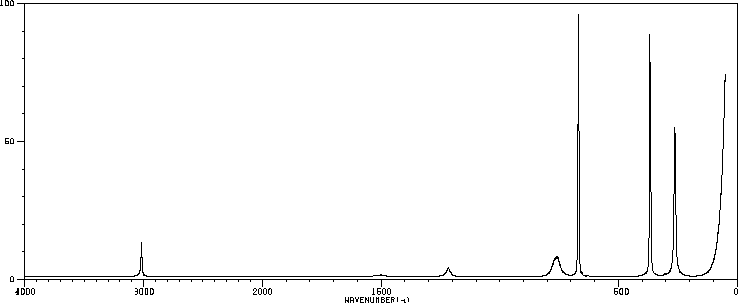氯仿 | 67-66-3
中文名称
氯仿
中文别名
哥罗仿,氯仿;三氯甲烷
英文名称
chloroform
英文别名
trichloromethane;CHCl3
CAS
67-66-3
化学式
CHCl3
mdl
MFCD00000826
分子量
119.378
InChiKey
HEDRZPFGACZZDS-UHFFFAOYSA-N
BEILSTEIN
——
EINECS
——
-
物化性质
-
计算性质
-
ADMET
-
安全信息
-
SDS
-
制备方法与用途
-
上下游信息
-
文献信息
-
表征谱图
-
同类化合物
-
相关功能分类
-
相关结构分类
物化性质
-
稳定性/保质期:
- 稳定性[21]:稳定。
- 禁配物[22]:碱类、铝。
- 避免接触的条件[23]:灼热、光照。
- 聚合危害[24]:不聚合。
- 分解产物[25]:氯化氢。
计算性质
-
辛醇/水分配系数(LogP):2.3
-
重原子数:4
-
可旋转键数:0
-
环数:0.0
-
sp3杂化的碳原子比例:1.0
-
拓扑面积:0
-
氢给体数:0
-
氢受体数:0
ADMET
代谢
当 (14)C-氯仿口服给予小鼠、大鼠和猴子时,在呼出的空气中发现了放射性。大多数剂量由猴子以不变的形式排出,小鼠以(14)CO2(二氧化碳)的形式排出,而大鼠则两种形式都有。在大鼠和小鼠的尿液中检测到三种代谢物,其中一种被鉴定为尿素。
When (14)C-chloroform was admin orally to mice, rats, & monkeys, radioactivity was found in expired air. Most of dose was excreted unchanged by monkeys, as (14)CO2 (carbon dioxide) by mice, & as both by rats. Three metabolites were detected in urine of rats & mice, one of which was identified as urea.
来源:Hazardous Substances Data Bank (HSDB)
代谢
Haloforms are metabolized to carbon monoxide by hepatic microsomal mixed function oxidases & this reaction is markedly stimulated by sulfhydryl cmpd. Max stimulation occurred at 0.5 mmol glutathione. A mechanism for conversion to carbon monoxide is proposed.
来源:Hazardous Substances Data Bank (HSDB)
代谢
Trihalomethanes (haloforms) were metab to carbon monoxide by rat liver microsomal fraction requiring nadph & molecular oxygen. Metabolism followed halide order; thus, chloroform yielded smallest amt. Results suggest cytochrome p450 dependent system.
来源:Hazardous Substances Data Bank (HSDB)
代谢
Deuterium-labeled chloroform was less toxic and less readily metabolized than /normal/ chloroform, suggesting that the cleavage of the C-H bond is the rate-limiting step in the process resulting in hepatotoxicity.
来源:Hazardous Substances Data Bank (HSDB)
代谢
氯仿主要通过肺部吸收。一旦进入体内,它会在含有脂质的器官中集中,如脂肪组织、中枢神经系统、肾脏和肝脏。它以原形通过呼出的空气排出,或者通过细胞色素P450机制在肝脏代谢,并随尿液和粪便排出。(A11)
Chloroform in absorbed mainly through the lungs. Once in the body it concentrates in lipid-containing organs such as the adipose tissue, the central nervous system, kidney and liver. It is eliminated unchanged in expired air or metabolized by the liver via a cytochrome P450 mechanism and excreted in the urine and faeces. (A11)
来源:Toxin and Toxin Target Database (T3DB)
毒理性
鉴定和使用:氯仿是一种清澈、无色的液体。它用于制造氟碳-22。氯仿是脂肪、油、橡胶、生物碱、蜡、古塔波胶、树脂的溶剂。它还用作清洁剂,以及在灭火器中用来降低四氯化碳的冻结温度,和在橡胶工业中使用。氯仿曾在第二次世界大战前作为麻醉剂和药物制剂使用。然而,这些用途已被禁止。
人体研究:在人类中,使用氯仿进行麻醉可能导致由于呼吸和心脏心律不齐及衰竭而死亡。在人类中还观察到肾小管坏死和肾功能不全。氯仿对粘膜有刺激性,可引起持续恶心和呕吐的胃肠炎。摄入氯仿后的症状与吸入后的症状相似。有报道称自杀尝试后出现严重中毒,症状模式与麻醉使用后相同。个体之间的易感性差异很大。一些人服用7.5克氯仿后出现严重疾病,而其他人则在服用270克氯仿后存活。长期暴露于100-1,000毫克/立方米(20-200 ppm)的氯仿浓度主要产生神经学效应,症状发生率增加,如疲劳、恶心、呕吐、乏力、口干和厌食。一些研究还观察到对肝脏的影响,包括黄疸、血清酶水平升高和肝脏增大。暴露于浓缩氯仿蒸气会在眼睛产生刺痛感。液体溅入眼睛会引起结膜组织的灼烧、疼痛和发红。偶尔损伤角膜上皮细胞,几天内可完全恢复。氯仿与代谢活化未能诱导人类淋巴细胞的染色体断裂或姐妹染色单体交换。皮肤接触氯仿会引起化学性皮炎(症状:刺激、发红、起泡和烧伤)。
动物研究:氯仿的氧化生物转化由细胞色素P-450催化,产生三氯甲醇。三氯甲醇失去氯化氢产生光气作为反应中间体。光气与组织蛋白的反应与细胞损伤和死亡有关。在大鼠和几种品系的小鼠中,肝脏是急性毒性的靶器官。肝脏损伤的特点是早期脂肪浸润和气球细胞,进而发展为中央小叶坏死,然后是大量坏死。在其它更敏感品系的雄性小鼠中,肾脏是靶器官。肾脏损伤从水泡变性开始,发展为近端小管的坏死。小鼠对氯仿毒性的敏感性高于大鼠。氯仿对啮齿动物肝脏和肾脏的致癌作用似乎与在靶器官观察到的细胞毒性和细胞增殖效应密切相关。氯仿诱导基因突变或对DNA造成其他类型直接损伤的能力很小,如果有的话。有两个问题可能影响对氯仿诱变性的解释。首先,光气与通常添加到美国药典(USP)氯仿中的乙醇反应产生的乙基和二乙基碳酸酯可能会产生假阳性结果。其次,由于氯仿的挥发性,氯仿的测试必须在密封系统中进行,因此没有考虑到这一因素的研究可能会给出假阴性结果。有一些有限的数据表明氯仿对胎儿有毒,但只有在对母体有毒的剂量下。
生态毒性研究:地表水中的氯仿水平通常较低,预计不会对水生生物构成威胁。然而,由于工业排放或泄漏导致地表水中氯仿水平较高,可能对某些水生物种的胚胎-幼虫阶段构成危害。
IDENTIFICATION AND USE: Chloroform is a clear, colorless liquid. It is used in the manufacture of fluorcarbon-22. Chloroform is a solvent for fats, oils, rubber, alkaloids, waxes, gutta-percha, resins. It is also used as cleansing agent, as well as in fire extinguishers to lower the freezing temperature of carbon tetrachloride, and in the rubber industry. Chloroform was formerly used as an anesthetic and in pharmaceutical preparation immediately prior to World War II. However, these uses have been banned. HUMAN STUDIES: In humans, anesthesia with chloroform may result in death due to respiratory and cardiac arrhythmias and failure. Renal tubular necrosis and renal dysfunction have also been observed in humans. Chloroform is irritating to mucous membranes, producing gastroenteritis with persistent nausea and vomiting. Symptoms following ingestion of chloroform are similar to those following inhalation. Cases of severe intoxication after suicidal attempts, with the same pattern of symptoms as after anesthetic use, have been reported. There are considerable inter-individual differences in susceptibility. Some persons presented serious illness after an oral dose of 7.5 g of chloroform, whereas others survived a dose of 270 g chloroform. Long term exposure to concentrations of 100-1,000 mg/cu m (20-200 ppm) of chloroform produce mainly neurological effects, with increased incidence of symptoms such as fatigue, nausea, vomiting, lassitude, dry mouth, and anorexia. Some studies also observed effects on the liver, including jaundice, increased serum enzyme levels, and increased liver size. Exposure to concentrated chloroform vapors causes a stinging sensation in the eye. Splashing of the liquid into the eye evokes burning, pain and redness of the conjunctival tissue. Occasional injury of the corneal epithelium will recover fully within a few days. Dermal contact with chloroform causes chemical dermatitis (symptoms: irritation, reddening, blistering and burns). Chloroform with metabolic activation failed to induce chromosome breakage or sister-chromatid exchanges in human lymphocytes. ANIMAL STUDIES: The oxidative biotransformation of chloroform is catalyzed by cytochrome P-450 to produce trichloromethanol. Loss of HCl from trichloromethanol produces phosgene as a reactive intermediate. The reaction of phosgene with tissue proteins is associated with cell damage and death. The liver is the target organ for acute toxicity in rats and several strains of mice. Liver damage is characterized by early fatty infiltration and balloon cells, progressing to centrilobular necrosis and then massive necrosis. The kidney is the target organ in male mice of other more sensitive strains. The kidney damage starts with hydropic degeneration and progresses to necrosis of the proximal tubules. Mice are more sensitive to chloroform toxicity than rats. The carcinogenic effects of chloroform on the liver and kidney of rodents appear to be closely related to cytotoxic and cell replicative effects observed in the target organs. Chloroform has little, if any, capability to induce gene mutation or other types of direct damage to DNA. Two problems potentially compromise the interpretation of mutagenicity data on chloroform. First, there is a possibility that ethyl and diethylcarbonate, produced by reaction of phosgene with ethanol that is routinely added to U.S.P (US Pharmacopoeia) chloroform, could generate false positive results. Secondly, testing of chloroform must be done in a sealed system because of its volatility, and so studies that did not take this factor into account could give false negative results. There are some limited data to suggest that chloroform is toxic to the fetus but only at doses that are maternally toxic. ECOTOXICITY STUDIES: Levels of chloroform in surface waters are generally low and would not be expected to present a hazard to aquatic organisms. However, higher levels of chloroform in surface water resulting from industrial discharges or spills may be hazardous to the embryo-larval stages of some aquatic species.
来源:Hazardous Substances Data Bank (HSDB)
毒理性
氯仿和氯仿代谢的活性中间产物,尤其是光气,会与细胞大分子共价结合并不可逆地导致肝脏和肾脏的细胞损伤。尽管确切的机制尚不明确,但已经证实光气会与半胱氨酸等分子反应,耗尽肝脏的谷胱甘肽,与微粒体蛋白形成加合物,并提高肝脏酶的水平。氯仿还被证实能够阻断HERG钾通道,导致心脏骤停。(L13, A11, A29)
Chloroform and the reactive intermediates of chloroform metabolism, especially phosgene, bind covalently and irreversibly to cellular macromolecules and cause cellular damage within the liver and kidney. While the exact mechanism is unknown, phosgene has been shown to react with molecules such as cysteine, deplete hepatic glutathione, form adducts with microsomal proteins, and elevate hepatic enzyme levels. Chloroform has also been shown to block HERG potassium channels, causing cardiac arrest. (L13, A11, A29)
来源:Toxin and Toxin Target Database (T3DB)
毒理性
癌症分类:B2组可能的人类致癌物
Cancer Classification: Group B2 Probable Human Carcinogen
来源:Hazardous Substances Data Bank (HSDB)
毒理性
证据权重特征:根据1986年美国环保局(EPA)的致癌风险评估指南,三氯甲烷被归类为B2组,即可能的人类致癌物,这一分类基于动物致癌性的“充分证据”(美国环保局,1998年)。根据《致癌风险评估指南(拟议稿)》(美国环保局,1996年;美国环保局,1999年),在高暴露条件下,三氯甲烷通过所有暴露途径可能导致人类致癌,这些条件会导致易感组织的细胞毒性和再生性增生(美国环保局,1998年)。在不会导致细胞毒性和细胞再生的暴露条件下,三氯甲烷不太可能通过任何暴露途径对人类致癌。
Weight-of-Evidence Characterization: Under the 1986 U.S. EPA Guidelines for Carcinogen Risk Assessment, chloroform has been classified as Group B2, probable human carcinogen, based on "sufficient evidence" of carcinogenicity in animals (U.S. EPA, 1998). Under the Proposed Guidelines for Carcinogen Risk Assessment (U.S. EPA, 1996; U.S. EPA, 1999), chloroform is likely to be carcinogenic to humans by all routes of exposure under high-exposure conditions that lead to cytotoxicity and regenerative hyperplasia in susceptible tissues (U.S. EPA, 1998). Chloroform is not likely to be carcinogenic to humans by any route of exposure under exposure conditions that do not cause cytotoxicity and cell regeneration.
来源:Hazardous Substances Data Bank (HSDB)
毒理性
Evaluation: There is inadequate evidence in humans for the carcinogenicity of chloroform. There is sufficient evidence in experimental animals for the carcinogenicity of chloroform. Overall evaluation: Chloroform is possibly carcinogenic to humans (Group 2B).
来源:Hazardous Substances Data Bank (HSDB)
吸收、分配和排泄
氯仿可以通过肺部吸收,从胃肠道以及在一定程度上通过皮肤吸收。吸入途径是人体吸收的主要来源。
Chloroform can be absorbed through lung, from GI tract and to some extent through skin. Inhalation route is ... primary source of ... absorption in man.
来源:Hazardous Substances Data Bank (HSDB)
吸收、分配和排泄
氯仿会迅速被吸收并分布到所有器官,在神经组织中相对浓度较高。在大鼠十二指肠内注射14C-氯仿后,24小时内,70%...未在呼出的空气中改变,4%作为14 (二氧化碳)...肝脏和程度较小的肾脏是形成CO2的主要器官。
Chloroform is rapidly absorbed & distributed to all organs, with relatively high concn in nervous tissue. After intraduodenal injection of (14)C-chloroform to rats, 70% ... was found unchanged in expired air & 4% as (14)CO2(carbon dioxide) during 24 hr. ... Liver and, to much lesser extent, kidney were main organs in which CO2 was formed.
来源:Hazardous Substances Data Bank (HSDB)
吸收、分配和排泄
在人体中,氯仿及其二氧化碳(CO2)代谢物的肺排泄,对于单次口服剂量0.5或1.0克的氯仿来说,占据了很大一部分。在9名受试者中,多达68%的剂量以原形排出,多达51%的 ;在8小时后,不超过4%的剂量以原形排出。
In man, pulmonary excretions of chloroform and its CO2 (carbon dioxide) metab account substantially for single oral dose of 0.5 or 1.0 g. Amongst 9 subjects, up to 68% of dose is excreted unchanged & up to 51% of CO2; not more than 4% of dose is excreted unchanged after 8 hr.
来源:Hazardous Substances Data Bank (HSDB)
吸收、分配和排泄
氯仿迅速穿过胎盘并进入胎儿循环。
... /Chloroform crosses/ placenta rapidly and enters fetal circulation.
来源:Hazardous Substances Data Bank (HSDB)
制备方法与用途
制备方法
用作溶剂、氟里昂的原料,也用于塑料、医药、农药及香料等工业。
合成制备方法-
酸碱洗涤法 先将工业品氯仿用水洗涤至中性,静置,弃去上层水液。然后与工业品浓硫酸(98%)以10:1混合,搅拌洗涤至酸洗液呈淡咖啡色。每次洗涤要充分,并静置分层去除酸液。经酸洗后的氯仿用15%的碳酸钠溶液以10:1比例混合,中和除酸至合格,静置后收集下层氯仿。最后加入少量工业无水碳酸钾进行蒸馏,收集中间馏出物(61~62℃),即为成品。
-
甲醇法 甲醇法又称甲醇氢氯化/氯化法。甲醇法制三氯甲烷分两步进行,首先是甲醇催化氢氯化制一氯甲烷,然后一氯甲烷热氯化制三氯甲烷。工业装置分为氢氯化、氯化、精馏、汽化4个工序。
-
氢氯化工序 由甲醇和氯化氢为原料生产一氯甲烷的方法可采用液相催化和固相催化两种。液相催化法是在75%~80%的氯化锌水溶液催化剂作用下,在压力0.05MPa,温度140~145℃条件下,甲醇和氯化氢发生如下反应: 反应气中除生成有一氯甲烷、水和二甲醚外,还有未反应的甲醇和氯化氢。本工序采用冷凝和吸收相结合的方法,将反应生成的水及未反应的甲醇、氯化氢与一氯甲烷气体分离,再用碱中和剩下的氯化氢。然后,反应气经压缩、冷却和干燥除去水分。最后送氯化工序作原料。
-
氯化工序 氯气在400~450℃下与一氯甲烷发生下列反应: 改变氯气与一氯甲烷的比例,即可调节产物中氯化物的分布。工业装置通过控制氯比和低氯化物再循环来达到主产三氯甲烷的目的。
-
精馏工序 一氯甲烷氯化后,经冷凝得到粗氯化液,再采用4塔工艺流程处理。在初馏塔中除去低沸物(氯化氢、一氯甲烷、二氯甲烷)。在三氯精馏塔中,除去四氯化碳等高沸物,而从塔顶得到三氯甲烷产品。在中间蒸出塔及四氯精馏塔中,分别除去三氯甲烷和四氯乙烯等高沸物,在四氯精馏塔顶得到四氯化碳产品。
-
上下游信息
反应信息
-
作为反应物:参考文献:名称:一种高完整性、高效的GPS整数模糊度解算方法摘要::在概率体积内获得允许整数模糊度假设的有效方法与整数假设检验方法相结合,以减少收敛时间到具有高概率的 GPS 载波相位整数。首先使用卡尔曼滤波器估计基线坐标、浮点模糊度和它们的协方差矩阵。为了减少假设集,然后应用协方差矩阵去相关方法,这是最小二乘模糊度去相关调整(LAMBDA)方法的主要贡献。通过多重假设 Wald 序列概率检验 (MHWSPT) 检验简化的可接受假设,以在给定概率下选择最可能的假设。DOI:10.1002/j.2161-4296.2003.tb00336.x
-
作为产物:参考文献:名称:DE176063摘要:公开号:
-
作为试剂:描述:参考文献:名称:Levene; Raymond, Journal of Biological Chemistry, 1933, vol. 102, p. 317,323摘要:DOI:
文献信息
-
Cell adhesion-inhibiting antiinflammatory and immune-suppressive compounds申请人:Abbott Laboratories公开号:US20040116518A1公开(公告)日:2004-06-17The present invention relates to novel cinnamide compounds that are useful for treating inflammatory and immune diseases and cerebral vasospasm, to pharmaceutical compositions containing these compounds, and to methods of inhibiting inflammation or suppressing immune response in a mammal.本发明涉及新型肉桂酰胺化合物,用于治疗炎症和免疫性疾病以及脑血管痉挛,以及含有这些化合物的药物组合物,以及在哺乳动物中抑制炎症或抑制免疫反应的方法。
-
Some Aspects of the Azide-Alkyne 1,3-Dipolar Cycloaddition Reaction作者:N. T. Pokhodylo、M. A. Tupychak、O. Ya. Shyyka、M. D. ObushakDOI:10.1134/s1070428019090082日期:2019.9Some peculiar features of two most commonly used catalytic systems (Cul and CuSOVsodium ascorbate) controlling the regioselectivity of 1,3-dipolar cycloaddition of azides to terminal alkynes have been studied. Their potentialities, main disadvantages, and limitations have been demonstrated by a number of examples, including reactions of low-molecular-weight azides and alkynes containing heterocyclic
-
Naphthalenediol-based bis(Salamo)-type homo- and heterotrinuclear cobalt(II) complexes: Syntheses, structures and magnetic properties作者:Han Zhang、Wen-Kui Dong、Yang Zhang、Sunday Folaranmi AkogunDOI:10.1016/j.poly.2017.05.051日期:2017.9M(OAc)2 (M = Ca(II), Sr(II) and Ba(II)). In the crystal structures, the three metal(II) atoms occupy both the N2O2 and O6 sites of the ligand (L)4− moiety. Owing to the different nature of the N2O2 and O6 sites of the ligand H4L, the introduction of two different metal(II) atoms to the site-selective moiety, when compared with complex 1, leads to the replacement of the central Co(II) atom by different摘要合成了具有新的无环双(Salamo)型配体H4L的同核和异三核Co(II)配合物,通过N2O2 Salamo部分的金属化,该配体具有C形的O6位。通过使H4L与3当量的Co(OAc)2·4 反应获得同三核配合物[Co3(L)(OAc)2(CH3OH)2]·2CHCl3(1)。异三核配合物[Co2(L)Ca(OAc)2](2),[Co2(L)Sr(OAc)2](3)和[Co2(L)Ba(OAc)2(H2O)]·2CH3C H(通过H4L与2当量的Co(OAc)2·4 和1当量的M(OAc)2(M = Ca(II),Sr(II)和Ba(II))反应获得4)。在晶体结构中,三个金属(II)原子同时占据了配体(L)4-的 和O6位。由于配体H4L的 和O6位点的性质不同,因此向位点选择部分引入了两个不同的金属(II)原子,与配合物1比较时,会导致中心Co(II)原子被不
-
4-[(bicycle heterocyclyl)-methyl and -hetero]-piperidines申请人:Janssen Pharmaceutica, N.V.公开号:US04695575A1公开(公告)日:1987-09-224-[(Bicyclic heterocyclyl)methyl and -hetero]-piperidines having antihistaminic and serotonin-antagonistic properties which compounds are useful agents in the treatment of allergic diseases.
-
Dynamic Kinetic Resolution of Alcohols by Enantioselective Silylation Enabled by Two Orthogonal Transition‐Metal Catalysts作者:Jan Seliger、Martin OestreichDOI:10.1002/anie.202010484日期:2021.1.4A nonenzymatic dynamic kinetic resolution of acyclic and cyclic benzylic alcohols is reported. The approach merges rapid transition‐metal‐catalyzed alcohol racemization and enantioselective Cu‐H‐catalyzed dehydrogenative Si‐O coupling of alcohols and hydrosilanes. The catalytic processes are orthogonal, and the racemization catalyst does not promote any background reactions such as the racemization
表征谱图
-
氢谱1HNMR
-
质谱MS
-
碳谱13CNMR
-
红外IR
-
拉曼Raman
-
峰位数据
-
峰位匹配
-
表征信息
同类化合物
顺式-2-氯环己基高氯酸盐
顺式-1-溴-2-氟-环己烷
顺式-1-叔丁基-4-氯环己烷
顺式-1,2-二氯环己烷
顺-1H,4H-十二氟环庚烷
镓,三(三氟甲基)-
镁二(1,1,2,2,3,3,4,4,5,5,6,6,7,7,8,8,8-十七氟-1-辛烷磺酸酯)
铵2,2,3,3,4,4,5,5,6,6,7,7,8,8,9,9,10,10,11,11,12,12,12-二十三氟十二烷酸盐
铜N-(2-氨基乙基)乙烷-1,2-二胺2-氰基胍二氯化盐酸
钾{[(十七氟辛基)磺酰基](甲基)氨基}乙酸酯
钠3-[(3-{[(十七氟辛基)磺酰基]氨基}丙基)(甲基)氨基]-1-丙烷磺酸酯
重氮基烯,(1-溴环己基)(1,1-二甲基乙基)-,1-氧化
辛酸,十五氟-,2-(1-羰基辛基)酰肼
赖氨酰-精氨酰-精氨酰-苯基丙氨酰-赖氨酰-赖氨酸
诱蝇羧酯B1
诱蝇羧酯
萘并[2,1-b]噻吩-1(2H)-酮
膦基硫杂酰胺,P,P-二(三氟甲基)-
脲,N-(4,5-二甲基-4H-吡唑-3-基)-
肼,(3-环戊基丙基)-,盐酸(1:1)
组织蛋白酶R
磷亚胺三氯化,(三氯甲基)-
碳标记全氟辛酸
碘甲烷与1-氮杂双环(4.2.0)辛烷高聚合物的化合物
碘甲烷-d2
碘甲烷-d1
碘甲烷-13C,d3
碘甲烷
碘环己烷
碘仿-d
碘仿
碘乙烷-D1
碘[三(三氟甲基)]锗烷
硫氰酸三氯甲基酯
甲烷,三氯氟-,水合物
甲次磺酰胺,N,N-二乙基-1,1,1-三氟-
甲次磺酰氯,氯二[(三氟甲基)硫代]-
甲基碘-12C
甲基溴-D1
甲基十一氟环己烷
甲基丙烯酸正乙基全氟辛烷磺
甲基三(三氟甲基)锗烷
甲基[二(三氟甲基)]磷烷
甲基1-氟环己甲酸酯
环戊-1-烯-1-基全氟丁烷-1-磺酸酯
环己烷甲酸4,4-二氟-1-羟基乙酯
环己烷,1-氟-2-碘-1-甲基-,(1R,2R)-rel-
环己基五氟丙烷酸酯
环己基(1-氟环己基)甲酮
烯丙基十七氟壬酸酯











